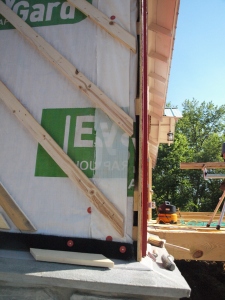I received an email today from a homeowner whose architect and GC wanted justification from a SIP expert regarding the question of roof venting on a SIP structure. The roof detail that provides “back-venting” is often called a “cold-roof”. However, in the context of SIPs, it would be far more accurate to refer to the detail as a “dry-roof”. The concept of a cold-roof is more applicable when we build up North and are concerned about ice-dams. The ventilation under the sheathing helps prevent the melting of snow and refreezing when the run-off reaches the overhang.
Whenever we strive to increase energy efficiency within a structure, it should be agreed that improving airtightness is as (if not more) important than increasing Thermal Resistance (R-Value). When we increase airtightness, we simultaneously decrease the building’s ability to dry.
Think of the 100+ year old barns that are still standing despite routinely getting wet. Without insulation, a structure is actually far more durable because it has a greater capacity to dry. The fastest way to do harm to an old timber frame barn is to pack it with insulation and fail to ensure a good means of drying. It will get wet, it will stay wet, it will rot, and it will fail!

All super-insulated and airtight structures need detailing that promotes a robust capacity to dry. This detail is often used behind siding and is known as a rain screen. The gap allows air to freely move in and out which also helps to dry the cladding and help dry any unintended wetting of the wall assembly’s exterior sheathing. The added benefit to this detail is it reduces thermal drive which causes premature paint failure. An additional benefit is increased sound resistance. The air gap helps to reduce the transfer of sound vibration through the assembly.
All the benefits of back-ventilating your siding are applicable to your roof. It will improve the durability of your structure by increasing the roof’s ability to dry when it gets wet. And, remember that Murphy says it will always get wet. Back-ventilating will improve the life of your cladding and it will help improve your STC performance (sound transmission class).
It is important to note that many types of wall and roof claddings are “self-ventilating”. This is where a material choice can make a big difference. If you opt to specify a slate, tile, or multi-crimp metal roof, your roof cladding is doing double duty as a finish and as a self-venting system. If you chose a standing seam or asphalt shingle roof, your decision to add venting could be one that increases the durability of the structure.
The location of your structure must also be considered!!! I tell builders that if they want to be crappy at their trade, they should go to Phoenix and build where the climate is more forgiving with stupid mistakes. If you’re in an arid climate or one that has very little rainfall, the decision to ventilate would likely be a waste of money. However, if you were in New England, skipping a ventilating detail could spell disaster.
The decision to ventilate or not should be based on
1. climate/location
2. cladding type
3. the building’s type of assembly.
Your building will always be more durable if you add ventilation!



Can one install a impermeable peel & stick membrane onto an OSB SIP roof and then install a metal roof in a dry climate? Or is it better to just install a vent channel underneath with furring strips and another layer of OSB?
LikeLike
Your question is predicated on a condition of a dry climate. However, the final design must also take into consideration the temperature. Since a peel & stick membrane is non-permeable, it acts as a vapor barrier. Good design that follows building science laws and code requirements will specify the vapor barrier on the “Warm” side of the assembly. If your dry climate is in Phoenix, then the VB should go on the outside and the peel & stick application is perfectly acceptable. However, if your dry climate is in the high desert mountains of Colorado, the temperature extremes would dictate that your VB be installed on the interior of the assembly. Hence, peel & stick would create a problem with the VB on the wrong side.
Most roofers and GC’s think of a peel & stick membrane only as a bullet proof assembly that will keep the building dry when the rain falls. What they often overlook is the fact that a large percentage of moisture related problems in structures don’t result in bulk water (Rain) issues. The problems stem from high moisture content in the indoor air that will condense when a dew point is reached (ie: warm moist air comes in contact with a cold surface) The VB must be properly spec’ed and installed to prevent this type of moisture problem.
Will peel & stick work in your application? Depends where you’re building.
If back venting is required, you have several options to create that air space. One of the easiest and least expensive forms of venting when metal roofs are installed is a polypropylene mat. This three dimensional weave create an airspace under the metal and provides additional drying capacity to the roof assembly.
LikeLike
Thank you for sharing more about how to use SIPs and how to know if they should be ventilated. I have been trying to decide if I need these in my home and I think it would be really nice if I could get more information on whether or not I need ventilation. It sounds like it is best to figure out what is best in my area, since that is most of what determines it. Now I just need to find someone to install these panels in my home, and then I can get professional advice from them. Thank you for the great post!
LikeLike
Thanks for the kind words, Grant! Tell me where you’re located and we can pass on advice on ventilation for your SIP roof. Also we can direct you to SIP suppliers and installers in your area.
LikeLike